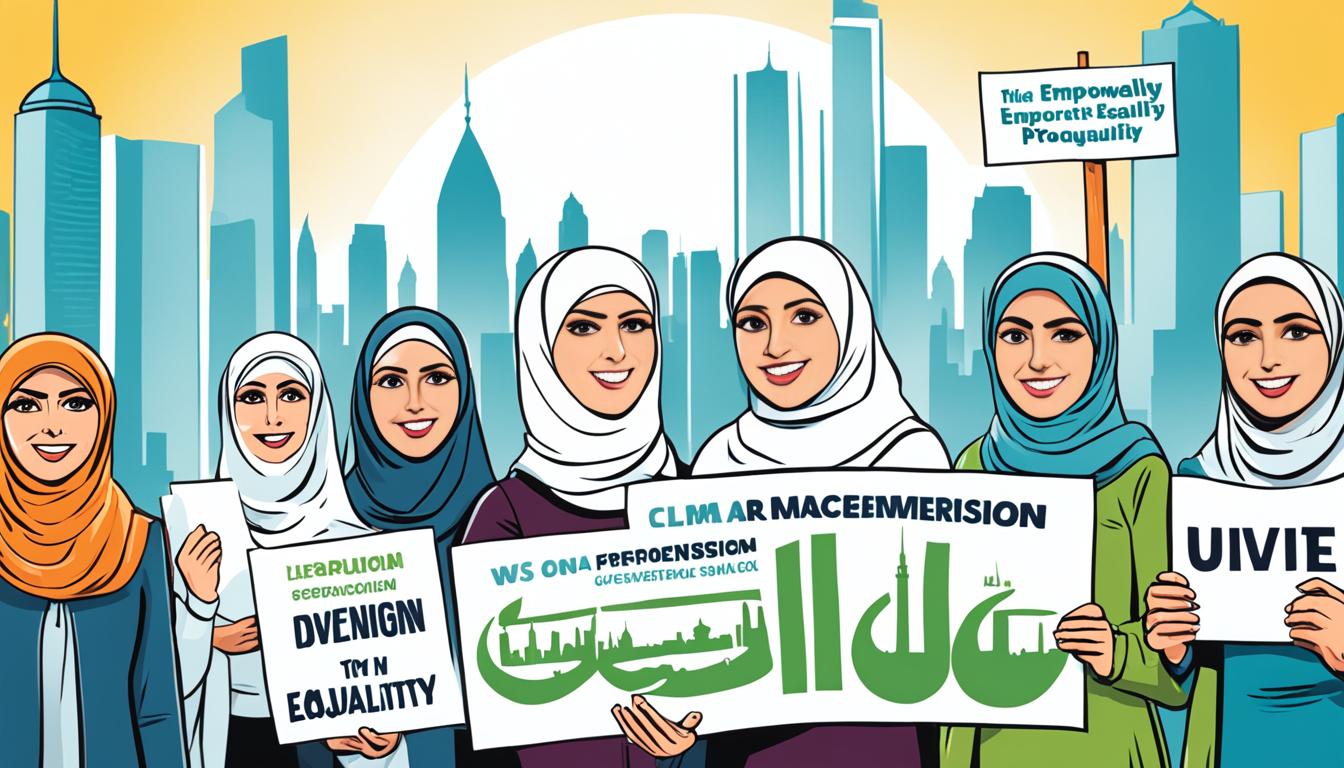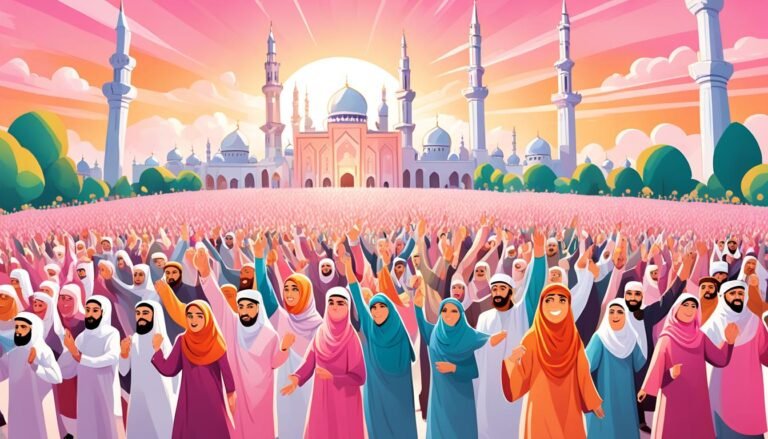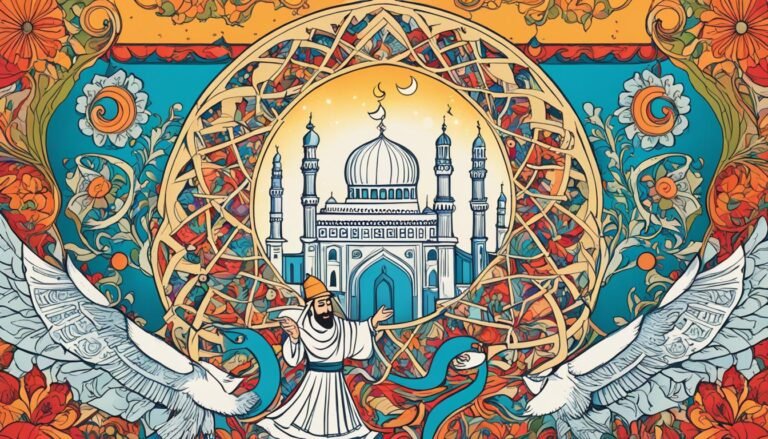The Role of Women in Modern Islamic Activism
What if women’s voices could change the future of gender equality in Islamic communities? Today, women’s roles in Islamic activism are key to understanding new stories about Islamic Feminism and women’s rights. They lead and influence, pushing for important changes based on history and the Quran.
Women first got the right to vote and be in parliament in Iran in 1963. Since then, they’ve faced many challenges. This article looks at how women are changing Islamic thought. Their activism fights for justice, equality, and respect in a fast-changing world.
Key Takeaways
- The pivotal role of women in advocating for gender equality within Islamic frameworks.
- Historical precedents of female empowerment in Islamic activism.
- The influence of female activists on modern Islamic Women’s Rights Movements.
- Challenges faced by women in activism today, including cultural misconceptions.
- Insights into the future landscape of women’s advocacy in Islamic communities.
Introduction to Islamic Feminism and Women’s Rights Movements
Islamic feminism started in the 1990s as a key movement for women’s rights in Islamic settings. It aims to understand Islam, especially the Qur’an, to support gender equality and fairness. Women’s rights in Islamic societies face big hurdles. Activists deal with local male dominance and Western views that see Muslim women as victims.
This movement combines global ideas with local activism. It began in the 1890s in Egypt, setting the stage for today’s efforts. In Egypt, activists push for women in leadership roles. In South Africa, they work for equal access to mosques.
Even though it’s growing, “Islamic feminism” is not widely known and sparks debate. It’s backed by Muslims, secular feminists, and former leftists. They fight for men and women’s equality in all areas of life. The Personal Status Law in Egypt from 2000 was a big step forward for women’s rights. But newer proposals face opposition from conservatives.
The debate on Islamic feminism is ongoing. A study in Egypt showed how new interpretations of the Qur’an can change views on women’s roles in society. Female religious leaders are key in tackling women’s issues by using religious texts to empower women in the Muslim world.
Understanding the Quranic Perspective on Gender Equality
The Quran sets the stage for gender equality in Islam. It says men and women come from the same soul, showing they are equal in God’s eyes. This is stated in the Qur’an 49:13, highlighting their shared essence and value.
But, history has led to different views on these teachings. Dr. Aziza al-Hibri points out that old traditions of men over women have shaped how we see these teachings today. These traditions often twist the meanings of verses, like surat al-Nisa’ 34th ayah, to support men’s power. Yet, there are other views that offer a fairer look at men and women’s roles.
Understanding the context of verses like surat al-Baqara 282 is key. Scholars say we must see these texts in their original settings to grasp their true meanings. The five main schools of Islamic law share core principles but adapt over time and place.
Islamic feminism started in the 19th century in Iran, thanks to figures like Tahirih Qurrat al-‘Ayn. Today, Amina Wadud shows how the Qur’an can be seen through a feminist view. This challenges old views on women’s rights in the holy book. The debate on Islamic feminism has grown since the 1990s, especially among scholars and in Muslim communities.
Women have faced barriers in religious education and tafsir, limiting their voice in understanding Islamic Texts. This has sparked talks on how to see gender roles in the Quran more inclusively.
The Role of Women in Modern Islamic Activism
Women in Islamic activism have grown in importance, building on a long history of Female Empowerment in Islam. Today, they are key in leading women’s rights movements in Muslim communities. They show strength and reform, pushing for women’s rights and dignity.
Historical Context of Female Empowerment in Islam
Islam has a strong tradition of empowering women, thanks to early leaders. Figures like Aisha showed strong leadership and took part in social and political issues. Today, women activists look to these leaders for inspiration to fight gender inequality and support women’s rights.
Contemporary Women’s Rights Movements in Muslim Societies
Now, women in the Muslim world are leading efforts that blend faith with social justice. In Kyrgyzstan, women run Islamic groups that focus on welfare and equality. During the COVID-19 pandemic, they provided vital services and brought the community together.
Groups like Datka-aiym help widowed or single women by supporting their businesses. This shows a strong commitment to helping those in need. Female religious leaders in Kyrgyzstan are also making a difference by connecting religious and secular parts of society. They work to build respect and understanding.
Women like Dahlia Ziada and Wahija al Huwaiter are part of a new wave of activists. They tackle long-standing human rights issues, making way for change. In some places, women are now outpacing men in university enrollment, entering fields once dominated by men.
| Region | Key Initiatives | Current Trends |
|---|---|---|
| Kyrgyzstan | Datka-aiym and welfare projects | Women’s leadership in social services |
| Middle East | Youth activism and human rights | Increased female enrollment in universities |
| North Africa | Family law reforms | Joint efforts of secular and Islamic feminists |
Female Muslim Activists Breaking Barriers
Female Muslim activists are changing the way we talk about gender and religion worldwide. They are breaking down old barriers, making it easier for cultural norms to change. Groups like the Indian Muslim Women’s Movement (BMMA), started in 2007, fight for women’s rights and challenge old ways of thinking.
Leaders like Daisy Khan from the Women’s Islamic Initiative in Spirituality and Equality (WISE) show how local movements can change policies and minds. They are powerful examples of how activism can make a big difference.
Prominent Figures in Today’s Islamic Activism
Today, we see strong leaders who are making a big impact. Names like Asra Nomani, Linda Sarsour, and Amina Wadud stand out among American Muslim women. They bring different views to the table, helping to change the conversation on important topics.
These activists show us what it means to break barriers and share the stories of Muslim women today. They inspire us to understand their challenges and support their cause.
The Impact of Activism on Cultural Dynamics
Female Muslim activists are fighting against stereotypes and creating new cultural norms. Groups like the All India Muslim Women’s Personal Law Board (AIMWPLB) are leading the way. Their work is changing how society sees women.
Research shows that activism is key to changing community views. By fighting for their rights, these activists help women gain power and tackle issues like discrimination.
| Organization | Year Established | Focus Areas |
|---|---|---|
| Indian Muslim Women’s Movement (BMMA) | 2007 | Women’s Rights, Gender Equality |
| All India Muslim Women’s Personal Law Board (AIMWPLB) | 2005 | Personal Law Reform |
| Bazme Khawateen | 1934 | Women’s Empowerment under Colonial Rule |
This work shows us the power of female Muslim activists. They are breaking barriers and creating a culture of equality and justice.
Religious Empowerment and Political Participation
Religious empowerment is key for women’s political involvement in Islamic societies. It helps women claim their women’s rights and take part in government. Algeria and Tunisia show this well, with Algeria at 31.6% and Tunisia at 31.3% women in their parliaments. Sudan has also seen a big jump, from 4% to 30.5% women in politics thanks to new laws.
Even with progress, there are still hurdles. The MENA region has a low 18% women in politics, below the world average. Countries like Saudi Arabia and Jordan are improving, with 19.9% and many female judges. But places like Qatar and Yemen still have no women in their parliaments. This shows we need to keep pushing for more women in politics.
Women in power are making a big difference. They fight for women’s rights and bring about social change. They inspire others to get involved in leadership and advocacy. By focusing on women’s rights as part of human rights, we can make sure everyone has the same chances. This way, empowerment helps not just individuals but also the whole community.
| Country | Women’s Political Representation | Notes |
|---|---|---|
| Algeria | 31.6% | Leading in female representation in MENA |
| Tunisia | 31.3% | Model for women’s empowerment |
| Sudan | 30.5% | Increased after reform of reserved seats |
| Saudi Arabia | 19.9% | Making strides in female participation |
| Jordan | Varies (approximately 50 female judges) | Significant role in judiciary |
| Qatar | 0% | Lowest representation |
| Yemen | 0% | Lowest representation |
Intersectional Perspectives in Islamic Feminism
Looking into Islamic feminism shows how class and wealth affect women’s lives in Muslim communities. These factors change how women experience their rights. By understanding this, we can make movements for Women’s Rights more inclusive.
The Influence of Class and Wealth on Women’s Rights
Women’s lives vary greatly based on their economic status. Wealthier women often get better education and political power. This helps them fight for change. On the other hand, women with less money face big hurdles, like not having access to education or a say in politics.
- Educational Opportunities: Wealthier women can go to college, which helps them know more about their rights.
- Political Capital: Having money means they can join in politics and lead in their communities.
- Social Networks: Rich women can connect with others, helping to spread their messages.
- Access to Resources: Money lets them keep fighting for Women’s Rights over time.
Intersectional views show we need to fight for all women’s rights, no matter their wealth. People like Sherin Khankan say it’s key to break down these social layers. They want to help all women, especially those who are overlooked.
Cultural Dynamics and Local Traditions
Cultural dynamics are key in shaping women’s roles in Muslim societies. Local traditions often take over, sometimes ignoring the Quran’s teachings on women’s rights. This mix leads to practices that go against women’s basic rights, making it hard for activists to push for gender equality.
In Arab societies, women’s roles in public life have been seen as limited. A review found only 44 articles on women’s leadership in 128 documents from 1995 to 2021. This shows women are underrepresented in leadership, with low economic participation rates worldwide.
Interpretations of Islam vary a lot. Some say men should protect women, while others push for equality. This debate affects how women fit into Islamic views. Leaders like Megawati Sukarnoputri and Benazir Bhutto show women can make a difference in governance.
Social class and wealth greatly affect women’s rights. Wealthy women get better education and job chances, letting them engage more in society. Poor women face big barriers, keeping inequality going.
For activists fighting for women’s rights, understanding these dynamics is key. They must work with local customs and push for a more equal Islam. This way, traditions can change to support women’s dignity and freedom.
Challenges Faced by Women in Activism
Women in activism face many challenges, especially in Muslim communities. Society often sets limits on their roles. Discrimination is a big hurdle, as women deal with deep-seated biases. These biases not only sideline them but also twist their efforts and goals.
Activists work hard to change these views. They want a chance to share their stories and push for changes that fit Islamic teachings.
Discrimination and Misinterpretations of Islamic Texts
For Muslim women in activism, there are big obstacles. Discrimination comes in many forms, making it hard for them to fight for equal rights. They often face wrong interpretations of Islamic texts that say women are less important or support men’s rule. These wrong views make people think Muslim women are trapped.
Worldwide, over half a billion women are Muslim, each facing different challenges. In Indonesia, the biggest Muslim-majority country, women deal with unique cultural and legal issues. In the Middle East and North Africa, media often distorts the truth about Muslim women’s lives.
Research shows that being Muslim doesn’t always mean women are treated poorly. Class, location, and laws also matter. In many places, men’s power keeps women down with early marriages, strict rules, and linking family honor to a woman’s purity. Women activists fight against these issues, aiming to change how people see their place in Islam.
| Challenges Faced | Description |
|---|---|
| Discrimination | Social, political, and economic exclusion impacting women’s rights and opportunities. |
| Misinterpretations | Distorted interpretations of Islamic texts that reinforce patriarchal norms. |
| Societal Norms | Ingrained cultural practices that dictate traditional gender roles, limiting activism. |
| Recognition in Leadership | Struggles for acknowledgment and resources in activism, with a focus on female leaders. |
Future of Women’s Advocacy in Islam
The landscape of women’s rights in Islamic contexts is changing fast, showing a bright Future of Advocacy. Young activists are leading the charge, blending traditional Islamic teachings with modern views. They aim to give women new roles in society.
In places like Pakistan, the fight for women’s rights is tough. Almost all people there hold some sexist beliefs, making it a dangerous place for women. With more focus on Islamic studies, there’s worry that women’s rights could take a step back.
Education is key to fighting against these negative trends. Programs that empower women can lead to lasting change. In many areas, women face big hurdles like poverty and lack of education. That’s why advocacy is crucial for their progress.
| Country | Challenges Faced | Women’s Advocacy Efforts |
|---|---|---|
| Pakistan | High sexism bias, government Islamisation | Increased activism, education reforms |
| Iran | Strict Sharia laws, political repression | Emerging feminist movements, legal challenges |
| Egypt | Poverty, patriarchy | Gender activism, redefining traditional roles |
The future of Islamic feminism will be key in improving women’s lives. By working together, we can make a difference. Changing views on things like how women dress and family laws is a big step towards equality.
Conclusion
The journey of Women in Islamic Activism is a powerful story. It shows how faith, culture, and the fight for gender equality are linked. Through studies like Maliha Marri’s dissertation, we see how important women are in Islamic communities.
Her research points out the challenges and changes in how people view women leaders in Islam. It shows the progress made in understanding women’s roles.
Historically, Islam has given women rights that were not there before. This change has helped women gain respect and more roles in society. Women like Benazir Bhutto have shown they can lead and inspire others.
Today, the movement of Women in Islamic Activism keeps growing. It’s driven by both local actions and big changes. It’s important to keep listening to these voices as we push for gender equality.
The struggle for women’s rights in Islam is ongoing. But with each step forward, we see a better future ahead. This underlines the need for equal respect and roles in all areas of life.
Source Links
- Reconstructed Lives: Women and Iran’s Islamic Revolution
- American Muslim Women, Religious Authority, and Activism
- No title found
- Exploring Islamic Feminism
- Women’s Rights and Islamic Feminism in Egypt – Georgetown Journal of International Affairs
- Five things you need to know about women in Islam: Implications for advancing women’s rights in the Middle East
- Women and the Qur’an: Feminist Interpretive Authority?
- The Importance of Female Islamic Activism in Kyrgyzstan
- Reformist Women Thinkers in the Islamic World
- Muslim Women’s Rights Activists’ Visibility: Stretching the Gendere…
- Muslim Women’s Activism in the USA: Politics of Diverse Resistance Strategies
- An increasing number of Muslim women in politics: A step towards complementarity, not equality
- Empowering Women in the Muslim World
- Muslim Feminists Are Not Here For Your Misconceptions About Their Faith
- The War on Muslim Women’s Bodies: A Critique of Western Feminism
- Women Leadership, Culture, and Islam: Female Voices from Jordan – Journal of Business Ethics
- Global Connections . Roles of Women
- 00001t.jpg
- Women in Islamic Societies: A Selected Review of Social Scientific Literature
- Women in the Civil Rights Movement | Articles and Essays | Civil Rights History Project | Digital Collections | Library of Congress
- Reflections on Islamisation and the Future of the Women’s Rights Mo…
- 00001t.tif
- Muslim female leadership
- The Rights of Women in Islam and Some Misconceptions An Analysis from Bangladesh Perspective
- Women in Islam







